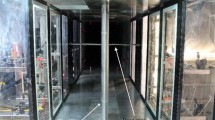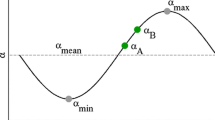Abstract
High-speed infrared thermography was applied for boundary-layer transition measurements on the upper side of helicopter rotors. The transition detection is based on the analysis of a single instantaneous thermal image of the rotating blade and allows the determination of both the locations of the onset and of the end of the transition region. Measurements were performed on a Mach-scaled BO105 model rotor for different rotation frequencies. The transition characteristics are presented and compared to two-dimensional numerical simulations, and the measurement scatter is discussed. Additional transition measurements were performed on the main rotors of the DLR research helicopters Eurocopter BO105 and EC135. The transition behavior of the EC135 rotor blade is presented for different cases, and the effect of the contamination of the rotor blade leading edge on the laminar flow is discussed.





















Similar content being viewed by others
Abbreviations
- \(\alpha \) :
-
Angle of attack (°)
- \(\rho _\infty \) :
-
Free stream density (kg/m\(^3\))
- \(c\) :
-
Chord (m)
- \(c_{\text {f}}\) :
-
Skin friction coefficient
- c p :
-
Specific heat capacity (J/kg K)
- c p :
-
Pressure coefficient
- \(d\) :
-
Diameter (m)
- \(f\) :
-
Rotation frequency (Hz)
- \(h\) :
-
Heat transfer coefficient
- \(I\) :
-
Intensity
- \(I_{\text {max}}\) :
-
Maximum intensity
- \(M\) :
-
Mach number
- \(R\) :
-
Rotor radius (m)
- \(r\) :
-
Radial coordinate (m)
- \(R_{{\text {cam}}}\) :
-
Radial position of the camera (m)
- \(Re\) :
-
Reynolds number
- \(St\) :
-
Stanton number
- \(t\) :
-
Thickness (m)
- \(t_{\text {max}}\) :
-
Maximum airfoil thickness (m)
- \(v_\infty \) :
-
Freestream velocity (m/s)
- \(v_{\text {max}}\) :
-
Maximum velocity (m/s)
- \(v_{{\text {min}}}\) :
-
Minimum velocity (m/s)
- \(v_{{\text {tip}}}\) :
-
Rotor blade tip speed (m/s)
- \(x\) :
-
Chordwise coordinate (m)
- \(z\) :
-
Vertical coordinate (m)
References
Drela M (1985) Two-dimensional aerodynamic design and analysis using the Euler equations. PhD thesis, Massachusetts Institute of Technology, Boston
Gartenberg E, Johnson WG, Wright RE, Carraway DL, Johnson CB (1992) Boundary-layer transition-detection in a cryogenic wind tunnel using infrared imaging. AIAA J 30(2):444–446. doi:10.2514/3.10936
Gauffre G (1988) Detection de la transition laminaire turbulent par thermographie infrarouge. La Recherche Aerospatiale, No. 2. pp 11–22, March–April 1988
Green MJ, Budnik MP, Yang L, Chiasson MP (1983) Supporting flight-data analysis for space-shuttle orbiter experiments at NASA Ames Research Center. NASA TM-84345
Heineck JT, Schülein E, Raffel M (2014) Boundary layer transition detection on a rotor blade using rotating mirror thermography. In: 5th decennial AHS aeromechanics specialists’ conference, San Francisco, CA, January 22–24, 2014
Horstmann KH, Quast A, Redeker G (1990) Flight and wind-tunnel investigations on boundary-layer transition. J Aircr 27(2):146–150. doi:10.2514/3.45910
McCroskey WJ (1971) Measurements of boundary layer transition, separation and streamline direction on rotating blades. NASA TN D-6321
Mori M, Novak L, Sekavčnik M, Kuštrin I (2008) Application of IR thermography as measuring method to study heat transfer on rotating surface. Forsch Ing 72:1–10. doi:10.1007/s10010-007-0062-8
Peake DJ, Bowker AJ, Lockyear SJ, Ellis F (1977) Non-obtrusive detection of transition region using an infra-red camera. AGARD CP-224
Quast A (1987) Detection of transition by infrared image technique. In: 12th international congress on instrumentation in aerospace simulation facilities (ICIASF 87), Williamsburg, VA, 22–25 June 1987
Raffel M, de Gregorio F, de Groot K, Schneider O, Gibertini G, Seraudie A (2011) On the generation of a helicopter aerodynamic database. Aeron J 115(1164):103–112
Riedel H, Sitzmann M (2002) Aspects of flow transition detection when flight testing engine nacelles. J Aircr 39(6):1019–1027. doi:10.2514/2.3030
Rohardt CH (1986) Strömungssichtbarmachung an Hubschrauberrotorblättern mittels Acenaphthen. German Aerospace Center (DLR) Report IB 129-86/18
Schlichting H, Gersten K (2000) Boundary-layer theory. In: 8th revised and enlarged edition, Springer, Berlin, ISBN 3-540-66270-7
Schülein E (2008) Experimental investigation of laminar flow control on a supersonic swept wing by suction. Paper AIAA-2008-4208, 4th Flow control conference, Seattle, Washington, 23–26 June 2008
Schülein E, Rosemann H, Schaber S (2012) Transition detection and skin friction measurements on rotating propeller blades. Paper AIAA-2012-3202, 28th AIAA aerodynamic measurement technology, ground testing and flight testing conference, New Orleans, Louisiana, 25–28 June 2012. doi:10.2514/6.2012-3202
Séraudie A, Perrauda J, Moens F (2003) Transition measurement and analysis on a swept wing in high lift configuration. Aerosp Sci Technol 7:569–576. doi:10.1016/j.ast.2003.04.001
Tanner WH, Yaggy PF (1966) Experimental boundary layer study on hovering rotors. J Am Helicopter Soc 11(3):22–37
van der Wall BG, Burley CL, Yu Y, Richard H, Pengel K, Beaumier P (2004) The HART II test—measurement of helicopter rotor wakes. Aerosp Sci Technol 8(4):273–284. doi:10.1016/j.ast.2004.01.001
Velkoff HR, Blaser DA, Jones KM (1971) Boundary-layer discontinuity on a helicopter rotor blade in hovering. J Aircr 8(2):101–107. doi:10.2514/3.4423610.2514/3.45910
Wadcock AJ, Yamauchi GK, Driver DM (1999) Skin friction measurements on a hovering full-scale tilt rotor. J Am Helicopter Soc 44(4):312–319
Yorita D, Asai K, Klein C, Henne U, Schaber S (2012) Transition detection on rotating propeller blades by means of temperature-sensitive paint. Paper AIAA-2012-1187, 50th AIAA aerospace sciences meeting, Nashville, Tennessee, 9–12 January 2012. doi:10.2514/6.2012-1187
Zuccher S, Saric WS (2008) Infrared thermography investigations in transitional supersonic boundary layers. Exp Fluids 44:145–157. doi:10.1007/s00348-007-0384-1
Acknowledgments
The authors would like to thank S. Kalow and J. Riemenschneider of the Institute of Composite Structures and Adaptive Systems of the DLR in Braunschweig for their support in performing the whirl tower test. For the conduction of the tests with the DLR helicopters, the authors would like to thank T. Wilmes and U. Göhmann of the DLR Facility for Flight Experiments in Braunschweig.
Author information
Authors and Affiliations
Corresponding author
Rights and permissions
About this article
Cite this article
Richter, K., Schülein, E. Boundary-layer transition measurements on hovering helicopter rotors by infrared thermography. Exp Fluids 55, 1755 (2014). https://doi.org/10.1007/s00348-014-1755-z
Received:
Revised:
Accepted:
Published:
DOI: https://doi.org/10.1007/s00348-014-1755-z




